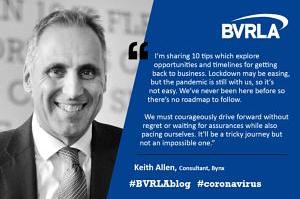Keith Allen, consultant at Bynx, shares 10 tips on exploring opportunities and timeline for getting back to business in the post Covid-19 world.

Lockdown may be easing, but the pandemic is still with us, so getting back to business is not easy. We’ve never been here before so there’s no roadmap to follow. We’re being challenged to go with what we know, fully utilise the experience we’ve amassed and have the courage to face the unknown with faith and leadership.
Many of you will be spending time collating information from industry leaders (from our industry and others) that could provide insight and help you on your way. Here at Bynx we’ve done much of the legwork and published our findings in a 21-page Back to Business Dossier. Here are 10 tips we’ve extracted exploring opportunities and timelines:
Opportunities
- An opportunity for vehicle leasing and finance providers is to proactively extend contracts to maintain revenues, reduce any hit on residual values and cut the cost (and challenge) of disposing of vehicles in a slow market.
- The use of grey fleet is set to increase as working practices shift and businesses ditch the company car. Managing grey fleet involves compliance and duty-of-care, which is an opportunity for fleet management companies to approach businesses and offer this service.
- Although short-term rental companies have seen their businesses decimate, the trend for on-demand transport, combined with a decreasing interest in car ownership are both driving opportunities and will continue to do so.
- The same is true for Mobility as a Service (MaaS) and is being strengthened by the rising adoption of connected devices and mobile payment systems.
- Governments across the world will continue to try and control urbanisation, traffic congestion and its environmental impact, which will open up opportunities for smaller, agile passenger transport providers.
Timeline
- Deloitte has issued guidance on workforce strategies, post COVID-19, citing the three timeframes of respond, recover, thrive, which we think apply to any business.
- Rather than “reacting” irrationally in the moment, we must give ourselves time and space to “respond” appropriately and with leadership. This takes empathy, rationality, transparency and vision.
- Recovery is a journey and the bridge between responding and thriving and it requires a mindset shift. Like all journeys, being prepared to navigate obstacles and bumps in the road is critical. Trust is the catalyst to recovery but is hard to instil in times of uncertainty. Leadership and transparency, however, will help restore trust.
- Thrive is where we prepare for the next normal and is an opportunity to be a market shaper. According to Deloitte, those who can shape the future, rather than adapt to it, will emerge stronger.
- The immediate future is about easing out of lockdown safely, while collaborating in meaningful ways with staff, partners, suppliers and (of course) customers so that we help each other move towards a future in which everyone can thrive.
We must courageously drive forward without regret or waiting for assurances while also pacing ourselves. It’ll be a tricky journey but not an impossible one.





